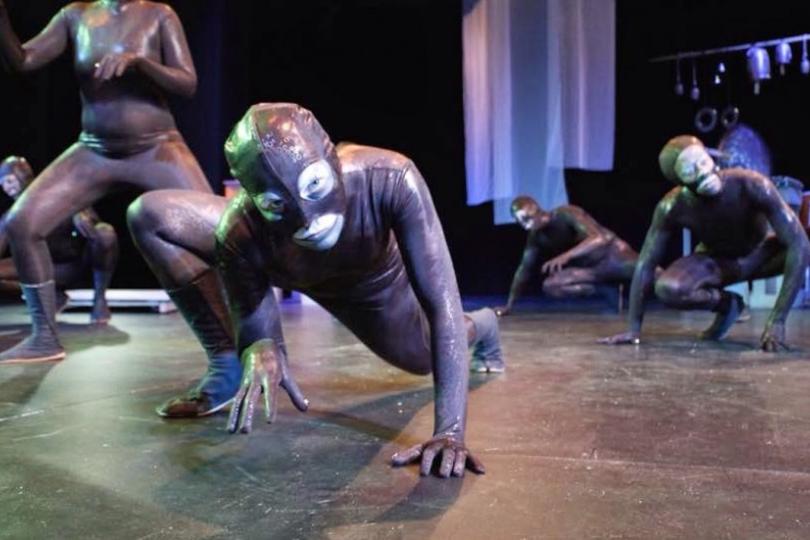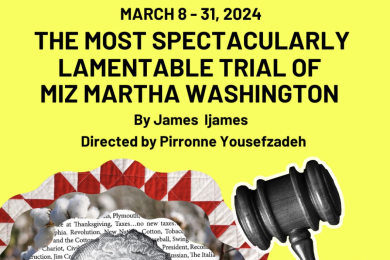To see the world as newts

War With the Newts is an odd little adventure, and odd little adventures happen to be a specialty of the Sandbox Theatre. The company has made a name for themselves with ensemble-created, highly physical works that are focused on telling good stories that take audiences off the beaten path.
Or in this case, out to sea. Their source material is a 1936 novel by Czech author Karl Čapek that uses sentient, human-sized newts as a parable for the many destructive powers of humankind, from environmental exploitation, to animal experimentation, to the slave trade and its aftermath. Being a classic work of science-fiction, “War With the Newts” isn’t particularly subtle in the parallels it draws between human-newt relations and real-life social issues. But the Sandbox has incorporated an innovative twist: rather than recounting events from the human perspective, it puts its words in the mouths of the newts.
In the Sandbox version, the human race has been wiped out, and the newts are recounting their story as a warning not to heed the humans’ example. As the audience, we find that we are not actually humans, but rather other newts meant to learn from our (the newts’) history of exploitation and ultimate triumph. In our roles as newts, we get to hear about human failings in the words of the new dominant race. And as an extra bonus, focusing on the newts provides the Sandbox with a fantastic opportunity to showcase its ensemble’s unique theatrical gifts.
Beautiful theatricality
Their artistry all begins with the costuming. Kathy Kohl and Mandi Johnson have dressed the cast in stretch black textured body suits with black and white face makeup, with an overall effect of making the actors look less like common amphibians than like oddly aquatic extraterrestrial beings. Physically, they walk with a bow-legged awkwardness but move their heads and arms with reptilian grace. Some of the actors seem to more fully inhabit their shiny new skins than others, but all seven cast members are believable as highly intelligent beings that are nonetheless completely and creepily non-human.
It is difficult to highlight individual cast members because of their full body covering – and although they each play unique characters at various points during the play, their performances in specific roles seem less important than their contributions to the ensemble as a whole. Rather than individual strengths, it was the collective moments that stood out: the choreography of a pearl diver swimming down to the depths of the sea, the range of clicks and whistles in the newts’ speech, odd feeling of being watched by a number of alien eyes.
The atmosphere was heightened further by the use of a variety of percussion and stringed instruments. Under Tim Donahue’s music direction, several different cast members alternately take up their posts at the back of the stage, creating a soundscape that perfectly echoes the feeling of not-quite-right foreignness that the company has clearly worked hard to build.
Conventional storytelling
All of the theatricality of this show was so well-orchestrated that I was surprised to find myself thinking that the storytelling itself felt rather conventional. When the newts decide to play human characters, donning masks and human-style clothing to indicate their roles, they come across just like human storytellers, losing some of the otherworldliness that initially makes them so intriguing to watch. (Maybe the newts are just too good at playing the roles of their human oppressors?)
As for the stories themselves, some of them hold together and are paced better than others. The second act’s “Story of the Talking Newt,” about a caged newt who learns to speak and understand human language, is heartbreaking both for the fate of the newt himself, and for what it tells us about how readily we dismiss – and then anthropologize – unfamiliar cultures rather than seeking common understanding. There are also some powerful moments, made stronger by the newts’ all-black costuming, that hearken back to the treatment of slaves and, later, domestic workers as inferior (and, indeed, as non-human).
But there is also some lag time where the target of the show’s parable feels either too obvious or too diffuse for the 21st century. Satirizing national stereotypes of France, Germany, England, and the U.S. felt a bit dated, and the tale of Captain von Toch’s and Mr. Bondy’s overzealous desire for pearls parodied capitalist greed in a way that we’ve seen before.
Stylistically, War With the Newts is beautiful, specific, and bizarre, but its narrative is far too mundane for its artistic ambitions. As a generously loose adaptation of a 1930’s novel, I think it could have been more pointed in the parallels it drew with modern sociopolitical issues, or at least more concise in its exploration of well-tread ground. Rather than honing in on the plot, I kept wanting the company to take its weirdest and most abstract moments – the music, the costumes, the movement, the whole concept of anthropomorphized newts – even further. The production sets in motion a strange and interesting artistic current, and with just a bit more of a push, it would have swept me away.
Confluence of Interest Alert (for those who care about these things): Derek Lee Miller, our News and Notes columnist, is the Artistic Director of Sandbox Theatre. MinnesotaPlaylist suspects that Sophie didn't even know that when she wrote this article.




